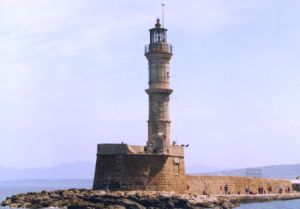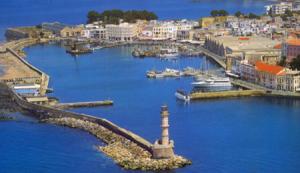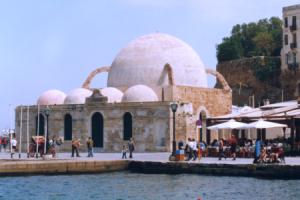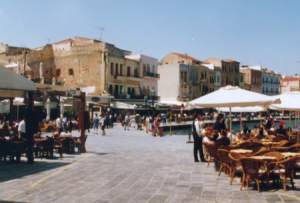|
Chania Town
 Welcome
to Chania, a beautiful and picturesque city with reminders
of the past at every corner. Chania is the main town in the
west of Crete, with the second largest
population after Heraklion. It
is divided into two parts: Welcome
to Chania, a beautiful and picturesque city with reminders
of the past at every corner. Chania is the main town in the
west of Crete, with the second largest
population after Heraklion. It
is divided into two parts:
The New Town
which is where the day to day business of the Chania goes
on, with its shops and offices, the post office and banks,
the renowned indoor market and the bus
station, and the Old Town,
built around the Venetian harbour with numerous picturesque
narrow streets and architecture showing the influence of decades
of foreign domination. Recent excavations have established
that the ancient city of Kydonia was located here also. The
first thing a visitor sees when reaching the town of Chania
is the Venetian harbour
and castle (Firka fort).
This image of the town has remained unspoiled throughout the
years, bringing back memories, when Chania was the governing
capital of Crete and the independence of the island was declared.
 The
town of Chania will be the starting point, to familiarize
yourself with the prefecture. The graphic seaside or mountainous
villages have their own pace of life, the famous Samaria
gorge, the steep White Mountains
of Crete, the endless beaches of
the Livikon Sea, the unspoiled seashores of Western Crete
and the small islets make up this beautiful island. An island
with wild, natural beauty, basking in sunlight and the blue
sea captivates visitors from the first moment and guarantees
further visits. Chania is the capital of the prefecture because
of its geographic position and commercial activity. For many
years was the governing centre of Crete and throughout history
has been under Arab, Venetian and Turkish occupation. As a
result, a blend of civilizations and unconquerable Cretan
spirit make up this island. The
town of Chania will be the starting point, to familiarize
yourself with the prefecture. The graphic seaside or mountainous
villages have their own pace of life, the famous Samaria
gorge, the steep White Mountains
of Crete, the endless beaches of
the Livikon Sea, the unspoiled seashores of Western Crete
and the small islets make up this beautiful island. An island
with wild, natural beauty, basking in sunlight and the blue
sea captivates visitors from the first moment and guarantees
further visits. Chania is the capital of the prefecture because
of its geographic position and commercial activity. For many
years was the governing centre of Crete and throughout history
has been under Arab, Venetian and Turkish occupation. As a
result, a blend of civilizations and unconquerable Cretan
spirit make up this island.
 The
city dates back to the Neolithic period and recent archaeological
digs on the acropolis of Kasteli have uncovered remains of
a significant Minoan community. Known as Kydonia in the past
it was one of the most important cities of Crete right up
to the Arabian seizure in 824 AD. The Venetians purchased
Crete in about 1204 but lost it to the Genoese between 1267
and 1290. The city of Chania was rebuilt on the site of the
Byzantine acropolis in 1252 and after improving the fortifications
at Kastelli the Venetians built their own cathedral plus many
palaces and houses in the surrounding area for their people.
In 1645, after a two month siege with terrible losses, the
Turks overwhelmed the whole island. Chania became the Turkish
island capital. Its churches were converted to mosques. Every
new building is designed and constructed with Turkish rythms
and many constructions like baths (hamams) mosques are saved
from that years. The Turks were expelled in 1898 when Prince
George became the High Commissioner of Crete, though the actions
of the Great Powers of Britain, France and Russia. The
city dates back to the Neolithic period and recent archaeological
digs on the acropolis of Kasteli have uncovered remains of
a significant Minoan community. Known as Kydonia in the past
it was one of the most important cities of Crete right up
to the Arabian seizure in 824 AD. The Venetians purchased
Crete in about 1204 but lost it to the Genoese between 1267
and 1290. The city of Chania was rebuilt on the site of the
Byzantine acropolis in 1252 and after improving the fortifications
at Kastelli the Venetians built their own cathedral plus many
palaces and houses in the surrounding area for their people.
In 1645, after a two month siege with terrible losses, the
Turks overwhelmed the whole island. Chania became the Turkish
island capital. Its churches were converted to mosques. Every
new building is designed and constructed with Turkish rythms
and many constructions like baths (hamams) mosques are saved
from that years. The Turks were expelled in 1898 when Prince
George became the High Commissioner of Crete, though the actions
of the Great Powers of Britain, France and Russia.
 The
official union of Crete with the rest of Greece, on December
13th, 1913, with the raising of the Greek flag on Firka fort,
led to a cease in turmoil and hard appression on the proud
and brave Cretan people. This pride and bravery was last called
on to fight against German occupation, when Chania was turned
into a battlefield in 1941 (battle of Crete). With distinguished
gallantry, the residents battled with the 3.500 German parachutists,
in the area of Maleme (20 km west of Chania). That same year,
the town of Chania was bombarded, destroying the largest part
of the Venetian citadel and eastern district of Splantzia. The
official union of Crete with the rest of Greece, on December
13th, 1913, with the raising of the Greek flag on Firka fort,
led to a cease in turmoil and hard appression on the proud
and brave Cretan people. This pride and bravery was last called
on to fight against German occupation, when Chania was turned
into a battlefield in 1941 (battle of Crete). With distinguished
gallantry, the residents battled with the 3.500 German parachutists,
in the area of Maleme (20 km west of Chania). That same year,
the town of Chania was bombarded, destroying the largest part
of the Venetian citadel and eastern district of Splantzia.
Worth visiting:
- The old town, around the
Venetian harbour, where you can see many graphic homes and
buildings from the Venetian period, giving the town a special
atmosphere. It is also the centre of night-life
with many bars and clubs. Don't forget to visit the lighthouse
and Firkas fort where during the summer months, many theatrical
performances and shows take place at the fort, which is
also a Naval museum.
- Skridlof street,
where visitors can find a great selection of hand made leather
goods. This area also called "Stivanadika".
- The archeological museum, on
Halidon street, has findings from all the prefecture
of Chania.
- The famous Municipal market
of Chania "Agora" shaped in a cross, situated
in Sofoklis Venizelos square.
Don't forget:
You must try the unique, speciality called "Bougatsa"
made with a secret recipe (like cheese-pie), and can be found
only on Apokoronou street.
Crete
| New Town |
Old Town | Firkas Fort
| Night-Life | Skridlof
str | Halidon str
| Municipal Market
|
